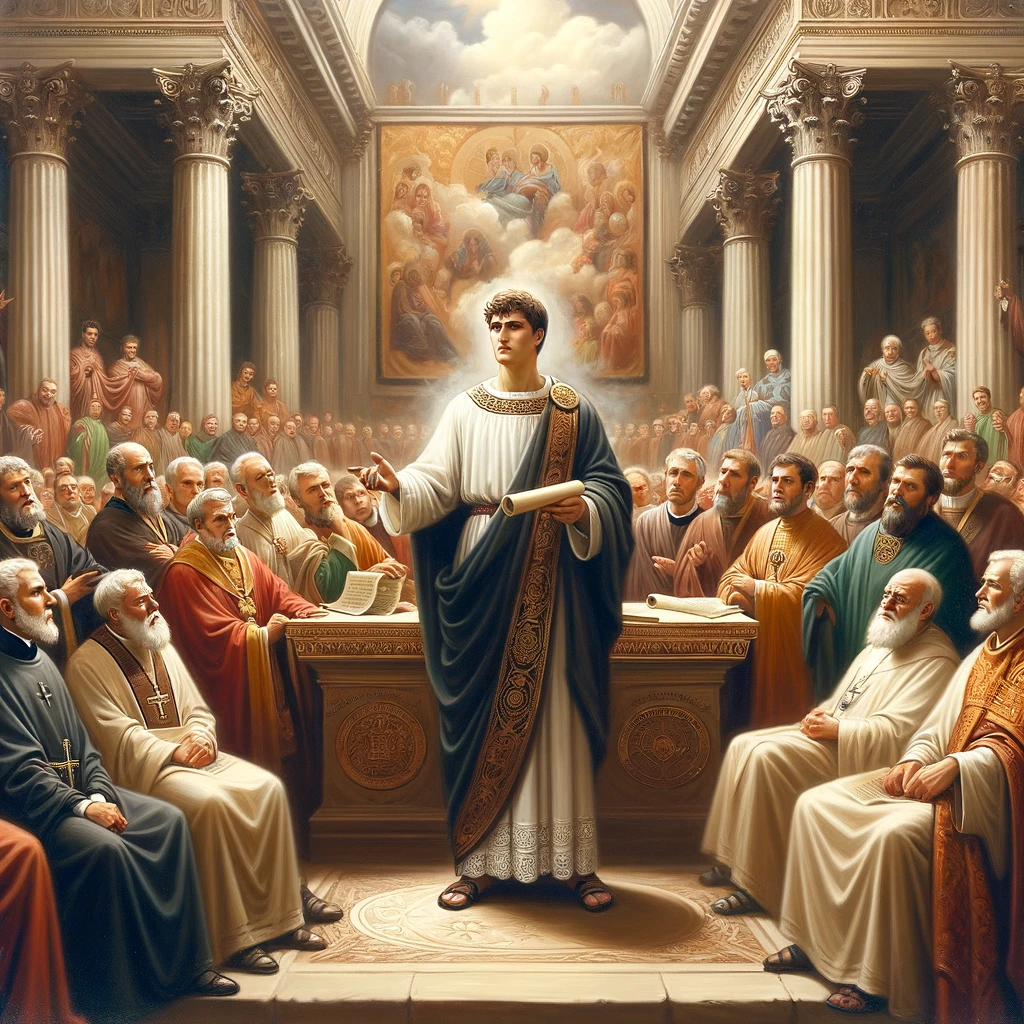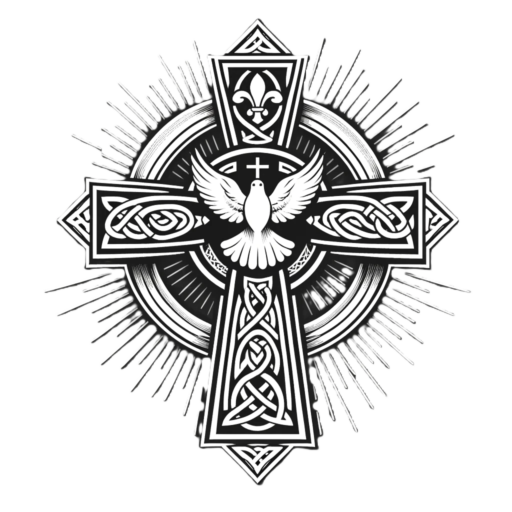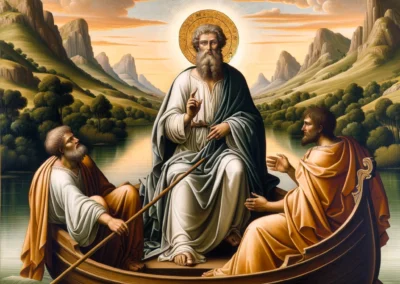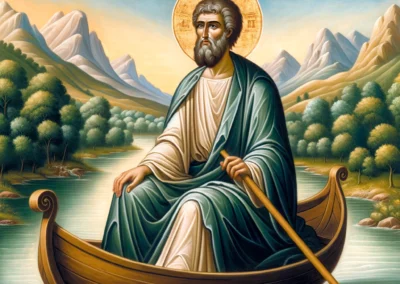Saint Athanasius: Defender of the Faith and Pillar of the Church
Birth and Early Life:
- Born in Egypt towards the end of the third century.
- Known from youth for piety, learning, and deep knowledge of sacred writings.
- Destined to be a champion and defender of the Church against Arian heresy.
Council of Nicæa (325 AD):
- Attended as a deacon with his bishop.
- Gained attention for his skillful defense of the faith.
Patriarch of Alexandria:
- Became Patriarch a few months after the council.
- Led the fight against Arianism for 46 years, often almost alone.
Conflict with Arianism:
- Refused to restore Arius to Catholic communion, leading to conflict with the emperor.
- The patriarch of Constantinople was ordered to restore Arius, leading to a dramatic event where Arius died before he could enter Sancta Sophia, thus preventing a sacrilege.
Persecutions and Character:
- Stood firm against four Roman emperors.
- Endured five exiles and constant threats from Arian opponents.
- Despite adversities, maintained a demeanor that was firm yet meek, humble, and beloved by his followers.
Death and Legacy (373 AD):
- Died peacefully, more due to his people’s desire than his enemies’ relenting.
- Left a profound theological legacy through writings that are rich, clear, and authoritative.
- Celebrated as one of the greatest Doctors of the Church.

Saint Athanasius was a deacon of about 27 years old at the Council of Nicaea. Estimated 300 bishops attended in the company of the Emperor Constantine the Great
Unveiling Arianism: The Enduring Impact and
Saint Athanasius’s Defiant Stand for Truth
Clever Words on the Nile:
The Quick-Witted Escape of Saint Athanasius
The story of Saint Athanasius’s clever escape down the Nile River is a testament to his quick wit and commitment to truth, even in the face of danger. During one of the periods of intense persecution instigated by his Arian adversaries, Athanasius found himself directly in the crosshairs of those who wished to capture and harm him due to his staunch defense of Nicene orthodoxy against Arianism.
As the story goes, Athanasius was being ferried down the Nile River when he realized that his pursuers were not far behind. Knowing that capture could mean his death, he devised a plan to evade them without compromising his moral integrity.
As his boat moved down the river, he spotted the boat of his pursuers approaching from the opposite direction. Realizing they might not recognize him by face, Athanasius calmly instructed his own boatmen to turn around and head back towards the pursuers.
As the boats drew near to each other, the pursuers shouted across to Athanasius’s boat, asking if they had seen Athanasius. Without a moment’s hesitation, Athanasius himself called back, “He is not far off.” This clever yet truthful response led his pursuers to continue their chase in the wrong direction, giving Athanasius the opportunity to escape.
Prayer in Honor of Saint Athanasius
Almighty ever-living God, who raised up the Bishop Saint Athanasius as an outstanding champion of your Son’s divinity, mercifully grant, that, rejoicing in his teaching and his protection, we may never cease to grow in knowledge and love of you. Through our Lord Jesus Christ, your Son, who lives and reigns with you in the unity of the Holy Spirit, God, for ever and ever.
Unveiling Arianism: The Enduring Impact and Saint Athanasius’s Defiant Stand for Truth
- Council of Nicaea (325 AD): Convened by Emperor Constantine, this first ecumenical council was primarily held to address the controversy caused by Arianism, which questioned the divinity of Jesus Christ.
- Condemnation of Arianism: The Catholic Church condemned Arianism because it denied the full divinity of Jesus, asserting He was a created being and not co-eternal with the Father, which contradicted the Church’s teaching of the Trinity and the eternal nature of Christ.
Condemnation of Arianism
Establishment of Orthodox Doctrine: The Council of Nicaea’s rejection of Arianism affirmed the doctrine of the Trinity, establishing that Christ is of the same substance (homoousios) as the Father, thus reinforcing the core Christian belief in the divinity of Jesus. This became a cornerstone of Christian orthodoxy.
Creedal Formulation: The Nicene Creed, formulated at the council, became a fundamental statement of Christian faith, recited in churches across the world, reinforcing the teachings opposed to Arianism.
Church Unity and Authority: The controversy and its resolution significantly shaped the role of ecumenical councils in defining orthodoxy and heresy, enhancing the centralized authority of the Church, particularly of the bishop of Rome (the Pope).
Political and Social Impact: The Arian controversy had lasting effects on the political landscape of the Roman Empire and beyond, influencing relationships between church leaders and state authorities, often intertwining theological disputes with political power struggles.
Remnants of Arianism
Despite its condemnation, Arianism did not disappear immediately and continued to influence certain regions and groups:
Gothic and Germanic Kingdoms: Some of the Germanic tribes that entered the Roman Empire, such as the Visigoths and Vandals, were Arian Christians. Arianism remained influential among these groups until they gradually converted to the Nicene Christianity of the broader empire.
Modern Groups: While mainstream Christianity does not adhere to Arian beliefs, some modern Christian sects and groups have been seen as having theological views reminiscent of Arianism, particularly those denying the traditional doctrine of the Trinity or the full divinity of Christ.
The legacy of the Arian controversy highlights the Church’s commitment to doctrinal purity and the lengths it has gone to preserve these foundational beliefs.
About the Modern Sects
Several modern Christian sects and groups hold beliefs that either deny the Trinity or the full divinity of Christ, differing significantly from mainstream Christian doctrines:
Jehovah’s Witnesses: They believe that Jesus is God’s first creation and not divine in the same way as God the Father. They reject the concept of the Trinity, describing it as a pagan influence on Christianity.
Mormonism (The Church of Jesus Christ of Latter-day Saints): While they affirm Jesus as divine, their view of the Trinity is substantially different from the traditional Christian doctrine. They believe that the Father, the Son, and the Holy Ghost are three distinct gods, which is a form of tritheism.
Christadelphians: They do not believe in the Trinity and view Jesus as wholly human before his resurrection, and divine only in the sense that he was filled with God’s Holy Spirit.
Unitarian Universalism: Originally rooted in Christianity, this religious movement now generally rejects the traditional Christian doctrine of the Trinity. They emphasize a singular divine essence and often view Jesus as an inspired human and a moral teacher rather than a divine being.
Oneness Pentecostalism: This group adheres to a non-traditional form of monotheism. They believe that God is a singular spirit who manifests in different modes, rather than three distinct persons. Thus, Jesus Christ is God manifest in flesh, which denies the co-equal, co-eternal nature of the persons of the Trinity as accepted in mainstream Christianity.
These sects represent a significant divergence from orthodox Christian theology, particularly concerning the nature of God and Christ, echoing some aspects of historical heresies like Arianism but also introducing new interpretations and beliefs.




